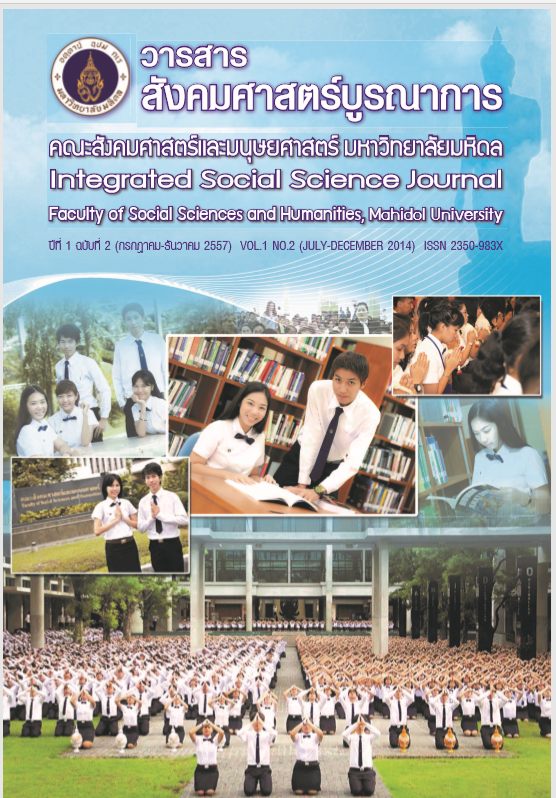Eco-Utopia 4: Four Green Cities of the 22nd Century.
Main Article Content
บทคัดย่อ
The futures of four cities across the globe (Macau, Panama City, Brasov and Beijing) are outlined via a single graphic scenario with textual support. These futures are presented in utopian terms, whereby each city is projected to exist within a peaceful and happy state and within a pronounced degree of ecological harmony. Some explanation about how each city can get to this utopian status by the year 2121 is offered along with a description about the social and economic background that may be present then and there.
Article Details
- วารสารสังคมศาสตร์บูรณาการ มหาวิทยาลัยมหิดล อนุญาตให้สามารถนำไฟล์บทความไปใช้ประโยชน์และเผยแพร่ต่อได้ โดยอยู่ภายใต้เงื่อนไขสัญญาอนุญาต CC Attribution-NonCommercial-NoDerivatives 4.0 International (CC BY-NC-ND 4.0) โดยต้องแสดงที่มา/การอ้างอิงจากวารสาร – ไม่ใช้เพื่อการค้า – ห้ามแก้ไขดัดแปลงเนื้อหา
- ข้อความที่ปรากฏในบทความในวารสารฯ เป็นความคิดเห็นส่วนตัวของผู้เขียนแต่ละท่าน ไม่เกี่ยวข้องกับกองบรรณาธิการวารสารฯ (ซึ่งหมายรวมถึง บรรณาธิการ ผู้ทรงคุณวุฒิในกองบรรณาธิการ หรือ บรรณาธิการรับเชิญ) แต่อย่างใด ความรับผิดชอบองค์ประกอบทั้งหมดของบทความแต่ละเรื่องเป็นของผู้เขียนแต่ละท่าน หากมีความผิดพลาดใด ๆ ผู้เขียนแต่ละท่านจะรับผิดชอบบทความของตนเอง ตลอดจนความรับผิดชอบด้านเนื้อหาและการตรวจร่างบทความเป็นของผู้เขียน ไม่เกี่ยวข้องกับกองบรรณาธิการวารสารฯ
- กองบรรณาธิการขอสงวนสิทธิ์ในการตัดทอน/ปรับแก้ถ้อยคำบางประการเพื่อความเหมาะสม
เอกสารอ้างอิง
Anderson, E.N. (2010) The Pursuit of Ecotopia: Lessons from Indigenous and Traditional Societies for the Human Ecology of our Modern World, Praeger: CA.
Bang, J.M. (2005) Ecovillages: A Practical Guide to Sustainable Communities, New Society Publishers.
Barros, C. (2009) Trees could be the ultimate in green power, New Scientist, Sept 10th 2009 issue.
Beardson, T (2013) Stumbling Giant: The Threats to China's Future, Yale University Press.
Beatley, T. (2010) Biophilic Cities: Integrating Nature Into Urban Design and Planning, Washington, DC: Island Press, 2010
Bortz, F. (2012) Meltdown!:The Nuclear Disaster in Japan and Our Energy Future, 21st Century Books: Connecticut
Callenbach, E.1975.Ecotopia.Banyan Tree Books, Berkeley.
Carrey, J. (2000) The Faber Book of Utopias, Faber: London.
Childs, J. (2007) The Gold Industry, Ethical Consumer online, 2007.
Chew, S.C. (2008) Ecological Futures, Altamira Press.
Chumley, C.A. (2013) China warns world: It’s time to ‘de-Americanize’, The Washington Times,Monday, October 14, 2013
Cleays, G. (2011) Searching For Utopia: The History of an Idea, Thames and Hudson.
DeGeus, M.(1999).Ecological Utopias: Envisioning the Sustainable Society. International Books, Utrecht.
deLacerda, L. and W. Salomons (1997) Mercury from Gold and Silver Mining: A Chemical Time Bomb?, Springer: Dordrecht.
Economy, E.C. (2010) The River Runs Black: The Environmental Challenge to China's Future. Council on Foreign Relations Books, Cornell University, Ithaca.
Forbes, S. and E. Ames. (2014) Money: How the Destruction of the Dollar Threatens the Global Economy – and What We Can Do About It, Macgraw-Hill.
Fuchs, R. (2010) Cities at Risk: Asia’s Coastal Citiesin an Age of Climate Change, Analysis from the East West Center, No 96, East West Center.
Gallagher, T. (2008) Modern Romania: The End of Communism, the Failure of Democratic Reform, and the Theft of a Nation, NYU Press.
Goldhill, O. (2014) China 'has more gold than official figures show', The Telegraph Online, April 8th, 2014.
Greer, J.M. (2013) Not the Future We Ordered: The Psychology of Peak Oil and the Myth of Eternal Progress, KarnacBooks.
Hao, Z (2011) Macau History and Society, Hong Kong University Press
Harmon, R. (2005) An Introduction to the Panama Canal Watershed, in R. Harmon, ed, The Rio Chagres, pp19-27, Springer.
Hitchens, K. (2002) A Concise History of Romania, Cambridge University Press
Ho P. and Vermeer, E. (eds) (2006) China’s Limits to Growth, Routledge.
Hilson, G. (2010) Child Labour in African Artisanal Mining Communities: Experiences from Northern Ghana, Development and Change, Volume 41, Issue 3, pages 445–473, May 2010
Hiscock, G. (2012) Earth Wars: The Battle for Global Resources: Wiley.
Hsu, C. (1997) Legalised Casino Gambling in the United States: the Economic and Social Impact, Routledge.
Hsu, M.Y. (2000) Dreaming of Gold, Stanford University Press, CA.
Jackson, H. and K. Svenson (2002) Ecovillage Living: Restoring the Earth and Her People, Green Books.
Karakiewcz, J. (2005) The City and the Mega-structure,in N. Dempsey, ed, Future Forms and Design for Sustainable Cities, pp137-152
Kellert, S. et al, eds.,(2008) Biophilic Design: The Theory, Science and Practice of Bringing Buildings to Life, New York: John Wiley and Son.
Kellert, S. (2005) Building for Life: Designing and Understanding the Human-Nature Connection, Washington, DC: Island Press, 2005.
Kellert, S.R. and Wilson, E. (1995) TheBiophilia Hypothesis, Island Press.
Klare, M.T. (2002) Resource Wars: The New Landscape of Global Conflict, Holt.
Kligman, G. (2001)On the social construction of "otherness" identifying "the Roma" in post-socialist communities, Review of Sociology, Vol. 7, No. 2, pp.61-78.
Lederwasch, A. (2012) Scenario Art: A New Futures Method that Uses Art to Support Decision-Making for Sustainable Development, Journal of Futures Studies, Vol. 17, Issue 1,pp.25-40
Mackay, R. (2008) Atlas of Endangered Species, University of California Press, CA.
Marius, T (1999) Thomas More: A Biography, Harvard University Press, Cambridge. MA.
Mayall, D. (2004) Gypsy Identities, 1500-2000.Google e-book
Mitchell, K. (2013) Gold Wars, Clarity Press.
More, T. (1515)Utopia,Reprinted in 1982 by Penguin Books, Harmondsworth, UK.
Mourdoukoutas, P. (2013) Can China Build A De-Americanized World? Forbes Magazine, 14th October, 2013.
Rabinowitz, A. (2007) Life in the Valley of Death: The Fight to Save Tigers in a Land of Guns, Gold, and Greed, Island press.
Sabol, S. (2003) Russian Colonization and the Genesis of Kazakh National Consciousness, Palgrave-MacMillan: NY.
Saul, N. and Tebbutt, S. (2005)Role of the Romanies: Images and Counter Images of 'Gypsies'/Romanies in European Cultures, Liverpool University Press.
Segal, H.P. (2012) Utopias: A Brief History from Ancient Writings to Virtual Communities, Wiley-Blackwell.
Shapiro, J. (2013) China’s Environmental Challenges, Polity Press.
Simpson, A (2012) Can gambling be sustainable?, Green Futures Magazine, Feb 20th Issue.
Spanos, C. (2008) Real Utopia: Participatory Society for the 21st Century, AK Press.
Worth, K.D. (2010) Peak Oil and the Second Great Depression, Outskirts Press.


